Better Healing in Less Time
The hamstrings are a group of three tendons that run down the back of the thigh to attach the thigh muscle to the bone and help you bend your leg at the knee.
They are very strong bands of tissue, so injuries to this area can be painful enough to not only halt your athletic training but also make standing, walking, and straightening the leg uncomfortable and difficult. This type of injury is very common among athletes of all types and generally occurs when running, jumping, or performing explosive activities that require bending the knee. And once you’ve done it, it’s more likely to happen again.
Sudden starts and stops, sprinting and lunging can overstretch or otherwise damage tissues leading to injuries that range in severity from a pull or strain to a partial or complete tear.
There are a number of reasons a person might suffer from a hamstring strain including failure to warm up properly before activity and poor overall flexibility. Regularly stretching and strengthening muscles before and after training, and even on rest days, reduces the risk of this type of injury.
Muscle imbalances are another common factor contributing to the likelihood of hamstring injuries. To work most efficiently, the hamstrings must work in partnership with the quadricep and glute muscles. When quad and glute strength don’t match what’s going on in the back of the leg, hamstrings can become overloaded and fail under the stress.
Worse still, after an injury to this area, the hamstrings tend to protectively constrict, becoming tighter and furthering inhibiting movement, making active recovery difficult to do on your own.
Sports chiropractic care can help in both the prevention and rehabilitation of hamstring injuries. Through specific strengthening and stretching exercises, the hamstrings can be better prepared for the regular stress of training. In addition, sports massage can break up constrictions in inflamed tissues so they are more pliable and have better mobility. Flexibility and range of motion are both enhanced after myofascial release and other soft tissue work because the muscles are more relaxed and blood flow to the area is increased.
At Dynamic Sports Medicine we can evaluate your body mechanics for full functionality in movement and ensure balance in major muscle groups. If your quads are too strong or your glutes too weak in relation to the condition of your hamstrings, we can offer specific strength work to balance you out.
Don’t let a hamstring injury keep you out of your game. Sports chiropractic care during rehab can lead to better and faster recovery outcomes.
Contact Dynamic Sports Medicine today.


